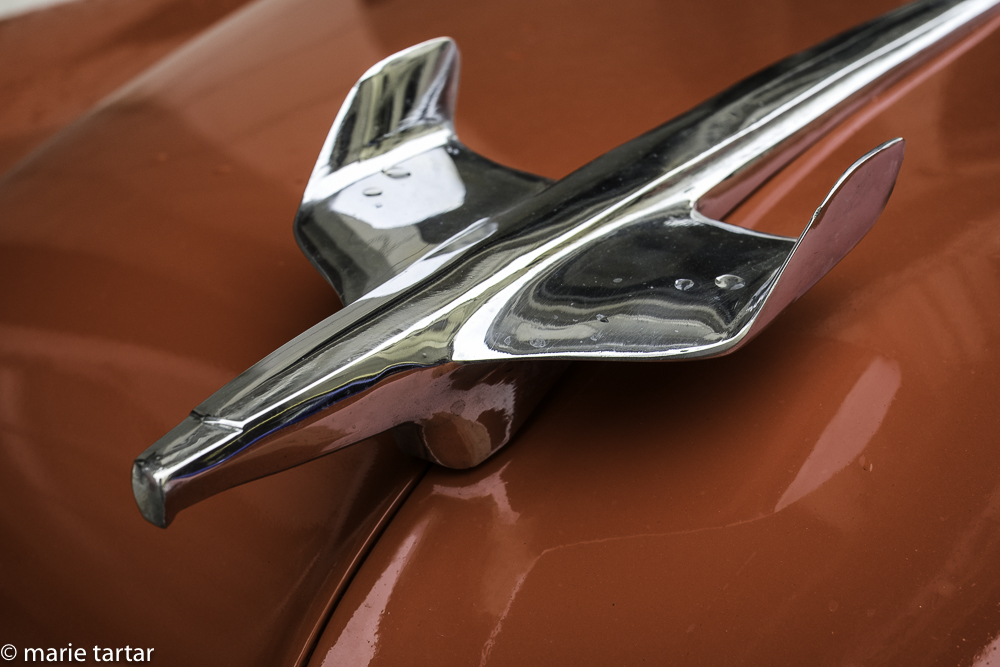
Cuba continues to reverberate in our thoughts, months after returning to our comfortable cocoon. The embassy reopened while we were underwater, and Secretary of State John Kerry was there soon afterwards to raise the US flag at the embassy. We definitely had the sense of being witness to historic times. Even Jardines de la Reina was in the news, with this article appearing in the New York Times on July 13, our departure day for Cuba.
http://www.nytimes.com/video/science/100000003788295/cubas-coral-garden.html
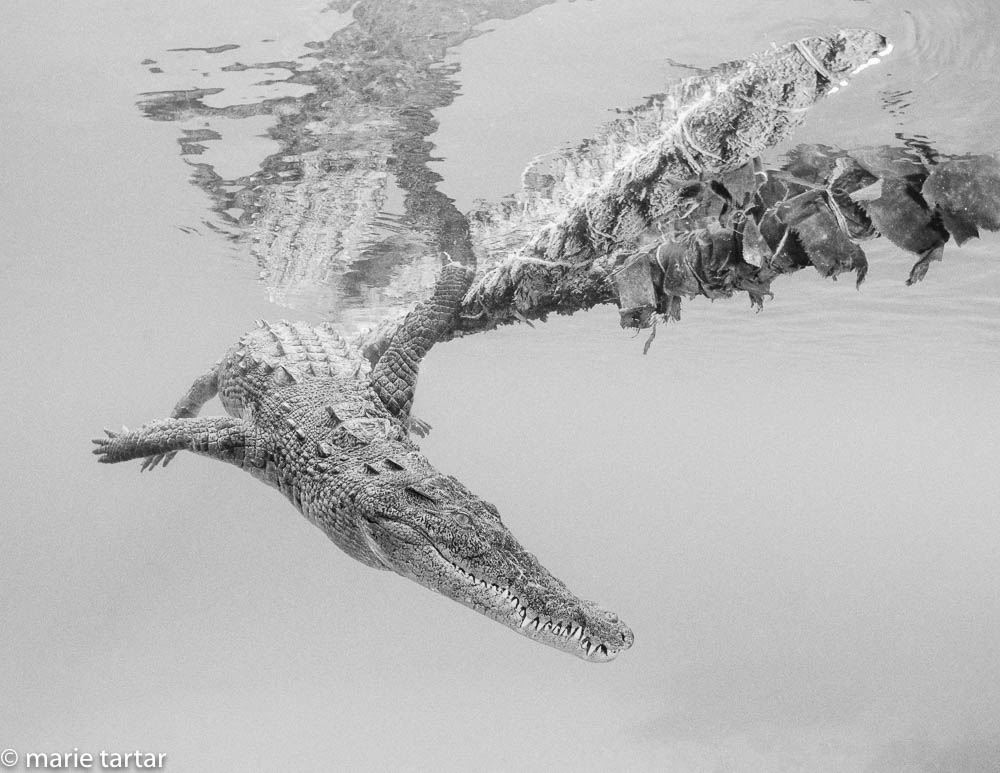
Tito, a “friendly,” American crocodile resident was a regular afternoon caller at our base on the Tortuga in Jardines de la Reina. This croc had a predilection for hanging off the barge’s mooring ropes, as pictured.
To say that our trip to Cuba was unforgettable is an understatement. The diving did not disappoint, with sharks, groupers and crocodiles, all in a remarkably lush coral reef and mangrove ecosystem. The trip denouement, put into motion by an 11th hour purse snatching on our last evening in the country, led to an unexpected 3 day “detention,” in which, without valid passports, we were unable to leave Cuba (details in Part 4: https://aperturephotoarts.com/down-and-out-in-havana-part-4-july-2015/). Like most ordeals, this was not entirely pleasant, but not without compensation.
“The difference between an adventure and an ordeal is attitude.”
― Bob Bitchin
From living the tourist high life in Havana, we ended up hoarding CUCs and hard-ball negotiating cab fares. The worst part of our ordeal was uncertainty. Not knowing if we would be able to leave in 2 days, 3 days or even longer, we had to make the cash we had cover our unexpected extended stay, new passports, airline change fees, all without the aid of ATMs or credit cards. Having to conserve our funds, we were still better off than most Cubans. The transformation was still informative, a mild version of “Trading Places.”
I came to sympathize with internationally known Cuban blogger, Yoani Sánchez, who relies on her European looks to gain access to hotels for Internet access. After we were no longer staying at the Hotel Parque Central, it was still our go-to place for Internet access. This was partly because of the location, partly because of the cost (half as much as the closer Melia Cohiba), but mostly because we knew their system and had some claim to “belonging” there, having stayed there 5 nights before the purse-snatching that set us adrift. Our casa particular had dial-up speed Internet, just enough to conduct their business, but not robust enough for guests.
I’ve mentioned in prior posts the Cuban monetary system, but haven’t fully explained the ramifications. The system is simple to understand. One CUC (Cuban convertible peso) equals one US dollar. Most transactions of a visitor, in hotels, museums, and restaurants, are conducted in CUCs. Although pegged to the US dollar, there is a 10% charge on conversion, leading us to take Euros, Canadian dollars and Mexican pesos with us, changing those first, before US dollars. Cubans are paid in moneda nacional, also called Cuban pesos or CUPs, worth 1/24 as much as a CUC. Cubans employed by the government are paid in CUPs. Tony, our lead dive guide, a marine biologist who formerly worked for the aquarium in Havana, is paid the equivalent of less than $20 USD as his monthly salary. Lucky for him, he receives tips in CUCs, Euros or equivalent, and thus is able to survive. This is the situation which leads doctors, paid by the government in CUPs, to moonlight as taxi drivers to gain access to tips and fares paid in CUCs.
During our “extension” in Havana, we saw much more clearly the lengths to which people are driven to get by, fostering low-level, but systemic, thievery. This ranged from skimming (shortchanging distracted tourists) to padding (charging unknowing tourists more for services, such as cab rides) to mild scams (our wildly inflated bar bill with our new “friends”). Actual thievery, such as my purse-snatching, purportedly is rare. Cubans to whom I described the episode (changing money, buying Internet service, cabbies) all reacted with surprise and horror, as though this was truly unusual. On the other hand, at the embassy, our passport official confirmed it was rare, but increasing. The boldness was striking. I was with a group, a block from a nice restaurant and a block from our nice hotel. We were on the dark side of the Museo de Bellas Artes, where I presume my thief was waiting for opportunity.
At our casa particular, Hosteria Cartacuba, the front gate was unlocked during the day, but locked at night. I noticed the elaborate floral metal rocking chairs on the inviting front porch were chained together. For a place that is “so safe,” there was an astonishing profusion of elaborate metal grillwork decorating/ protecting windows and doors and enclosing yards.
It was certainly an expensive mistake. $700 in airline change fees, new passport fees, a new phone (I did get a chance to upgrade), an overnight in DFW, and worse of all, 6 days lost at work. It turns out, we have a $10,000 deductible on our home owner’s policy-too bad we couldn’t count the lost days at work toward it! Moral of story: always leave the non-essentials in the hotel. My purse-snatching would have been much less painful had it only involved the purse, ID, money and phone, minus the passports!
On the flip side, we did see another Havana, which wasn’t all bad. The casa particular experience (minus the crunched cockroach and overflowing air conditioner) was mostly enjoyable, especially the communal meals with travelers from around the world. We enjoyed chatting with Yanila, who was a sharp and charming entrepreneur. In fact, the nicest, nothing-to-sell conversations I had with Cubans were with Yani and Angél, a Coco driver, examples of the rising, modestly prosperous, middle class who are benefiting from loosening in recent years of regulations governing self-employment.
Having enjoyed so much autonomy in our lives, to live where we want, pursue our desired course of study and professions, to travel, it was strange to bump up against unfamiliar constraints in connection with this trip, both coming and going. From Steve being unable to leave as planned for want of a passport (Part 1: https://aperturephotoarts.com/scuba-in-cuba-july-2015-part-1-going/ ), to neither of us being able to leave Cuba when planned for want of valid passports (https://aperturephotoarts.com/down-and-out-in-havana-part-4-july-2015/), we were certainly reminded what a privilege it is to come and go. This disruption was inconvenient, but not catastrophic, although I wondered how less fortunate travelers without cash reserves would have fared. Our greatest difficulty was the uncertainty of how long our detention would be, and how long we would have to manage with dwindling resources, not to mention lack of telephone service and sketchy Internet access.
Losing my phone redirected my reading temporarily. I was halfway through Viet Thanh Nguyen’s darkly hilarious The Sympathizer, saving the second half for the plane ride home, perfectly timed for my book club 2 days after our intended return. My “books” vanished with my phone and the Kindle app, down a dark maze of streets in Havana Vieja with my purse-snatcher. Steve hadn’t downloaded the book, and our Internet access was wobbly when we had it. Luckily, he had downloaded a locally redolent selection, Hemingway’s The Old Man and the Sea, written by Hemingway while living in Cuba and based on his experiences there with the local fishermen. Hemingway’s presence is still palpable in Havana, and with our extra days, Steve and I were able to further follow his trail, including a hotel he stayed at on his first visit in 1928, Hotel Ambos Mundos.
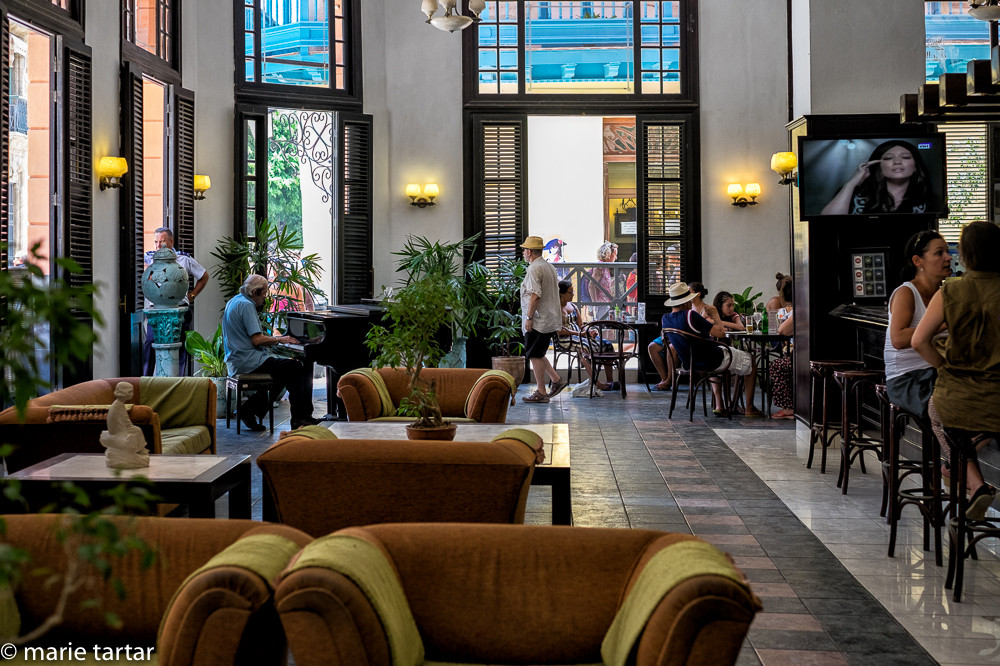
Hotel Ambos Mundos (both worlds) is well located in Havana Vieja, at the corner of Obispo and Mercaderes. The hotel and many buildings in the neighborhood have been undergoing restoration under the auspices of Habaguanex S.A
At the time, Hemingway and his second wife, Pauline, were living in Key West, Florida and laid over for 3 days waiting to board a ship bound for Spain. Still living in Key West, he returned to Cuba in 1932 and 1933 for marlin fishing.
He purchased his fishing boat, Pilar (a nickname for Pauline) the following year. It can be seen at his residence outside of Havana, Finca La Vigía (Lookout Farm), which he purchased with his third wife, Martha Gellhorn, in 1940 and was to occupy until he decamped to Idaho in 1959. The Old Man and the Sea deserves its status as a classic, perhaps the ultimate metaphor for endurance. An epic struggle, a chance at redemption, forces beyond one’s control, all rolled into a compelling, short but gripping, enduring tale. While our struggle to “survive” without Internet, phone, ATM, and credit cards was never life-threatening, the uncertainty and stress were challenges.
The “almendrones” or big almonds, one of many nicknames given to the vintage, mostly American, cars cruising the streets of Havana merit addition comments.
The colorful bubbles made me think often of my late father, who loved cars, especially from this era. Our friend Alice visited Cuba with her husband Doug a year before us and her summary explains well how it is that these ancient vehicles are still in active service:

Detroit’s finest models of the 1950s, still in service as taxis, attests to the ingenuity of Cuban mechanics having to “make do.”
“At the time of Fidel’s rise, American business interests in Cuba were huge. Americans owned ninety percent of the telephone and electric services, about half of the railways, the largest chain of supermarkets, several large retail stores, and roughly forty percent of the raw sugar production. Tourism was yet another sector heavily impacted by U.S. investment. Cuba offered everything Las Vegas could, plus beaches and cooler summer temperatures. Dozens of new hotels and motels were built during the fifties. With a corrupt dictator on their payroll and cheap and talented staff and entertainers, the choice between investing in Las Vegas or Havana was easy.
Between 1954 and 1956 alone, new foreign investments quadrupled, flowing into almost every strategic sector of the Cuban economy. Money was flowing fast and easy, and both U.S. ex-pats and locals spent some of it on importing the latest cars from the U.S.
That was until the 1959 revolution, shortly after which the Detroit auto giants and all American manufacturers had to cut-off sales to conform to the US embargo. Of the roughly 150,000 cars in Cuba at the time of the revolution, it is estimated that 60,000 are still rolling. While a very few have been “cherried-out” into pristine condition in which to drive tourists, the bulk of them are on life-support.
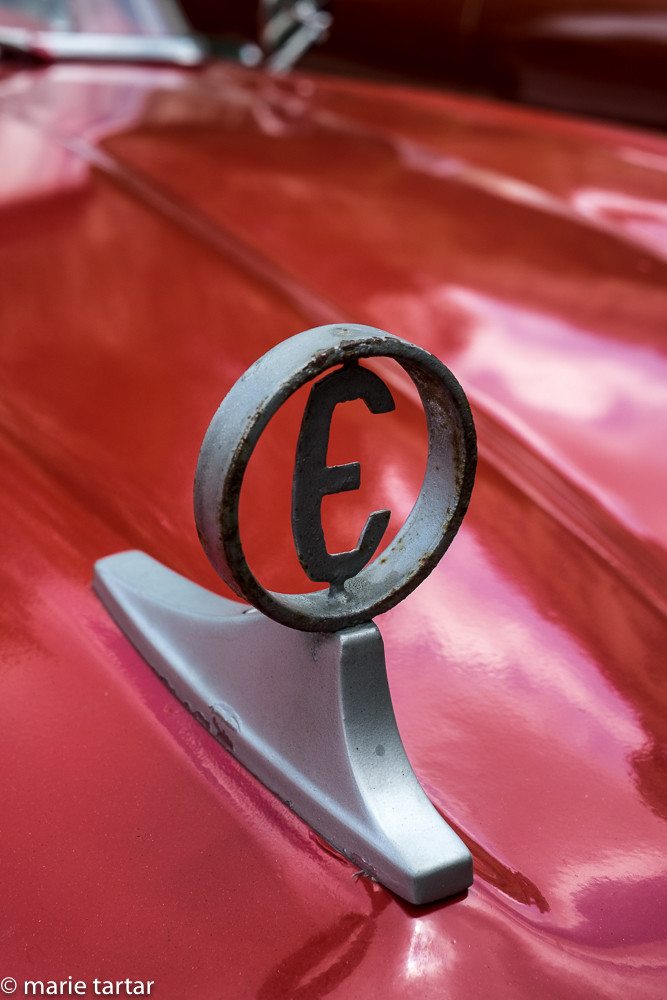
“E” for Eilenberg? No, for Edsel! Edsel was a short-lived division of Ford, launched in Steve’s birth month, September 1957 and folded 2 years later. Edsel later became a short-hand term for marketing disasters, or failure in general. Hhmm, maybe a metaphor for the regime?
In fact, it is a constant preoccupation to keep these 50+ year old vehicles running since auto part replacements are also part of the embargo. Diesel motors from Russian Ladas have long since replaced Detroit engines, and there is a huge market in hand-wrought replacement parts.”

My personal favorite of the many fanciful hood ornaments proudly adorning the fleet of vintage taxis near Parque Central
So, how did this situation ever come to be?
History is always difficult to succinctly distill, and Cuban history is no exception. Following Christopher Columbus’ arrival in 1492, Cuba was colonized for most of the next 4 centuries predominantly by the Spanish, who were finally ousted in 1898, more than half a century after Spanish rule was overthrown in most other Latin American countries. Slavery, introduced in the 1522 and abolished in 1886, was the other dominant factor shaping pre-20th century Cuba. US involvement in Cuban independence struggles against Spain led to the 1898 final showdown, the Spanish-American War. US involvement continued with the Platt Amendment to the 1901 Army Appropriations Bill, giving the US the right to intervene militarily in Cuba, as well as procuring the US a naval base in Guantánamo Bay, with an eye to protecting strategic interests in the Panama Canal region. Cuba was semi-independent until the Castro coup of 1959, although strongly influenced by the US, as Alice’s summary well describes.
Although nominally independent, this framework can certainly be viewed as Cuba swapping Spanish domination for American.
My sister Clarissa’s comments help to frame the context of the Cuban revolution:
“There is widespread thought that the current regime is a failure – there are shortages, lack of liberty, and there is paranoia and dissent in many quarters. So, some visitors then infer that everyone in Cuba believes the Communist revolution itself was a failure, and what was there before couldn’t have been so bad. That’s another American viewpoint – that capitalism basically works for everyone.
But to Cubans, the 1950s were pretty bad – capitalism propped up by a corrupt dictatorship. The average person couldn’t get ahead, and the Batista regime held power through brute force – the human rights abuses were so well known they are even joked about in “Our Man in Havana”. Cuba before the revolution no doubt was a fun place for Americans to visit, but it was also a powder keg – the disparity between the rich and poor was vast. The people we met on our trip in 2012 also commented on sort of an urban/rural split, that support for the revolution – even to the Castro regime in its current state – remains ” very strong” in rural areas…I would assume possibly because some of those areas get funding that had never existed pre-1959… I think to understand current Cuba, you… need to look at the historical backdrop to the revolution.
On October 6, 1960, Senator John F. Kennedy, in the midst of his campaign for the U.S. Presidency, decried Batista’s relationship with the U.S. government and criticized the Eisenhower administration for supporting him:
“Fulgencio Batista murdered 20,000 Cubans in seven years … and he turned Democratic Cuba into a complete police state—destroying every individual liberty. Yet our aid to his regime, and the ineptness of our policies, enabled Batista to invoke the name of the United States in support of his reign of terror. Administration spokesmen publicly praised Batista—hailed him as a staunch ally and a good friend—at a time when Batista was murdering thousands, destroying the last vestiges of freedom, and stealing hundreds of millions of dollars from the Cuban people, and we failed to press for free elections.”
It’s interesting to speculate how the course of history might have been different if…in 1952, a young lawyer named Fidel Castro was to have stood for a seat in the House of Representatives, but the elections were cancelled by Batista, who re-seized power the same year in a coup. (Batista first became president in 1933 in a political coup.) Fidel’s efforts to oust Batista led him to organize an armed assault on a stockpile of arms at the Moncada Barracks, outside Santiago de Cuba. This effort was a failure, with rebels executed without trial, arrested and put on trial. Fidel was sentenced to 15 years, but was released in 1955. July 26, the anniversary of the Moncada Barracks attack, is now a national holiday, el Día de la Rebeldía Nacional. It was this holiday which closed the embassy for the long weekend when we found ourselves passport-less.
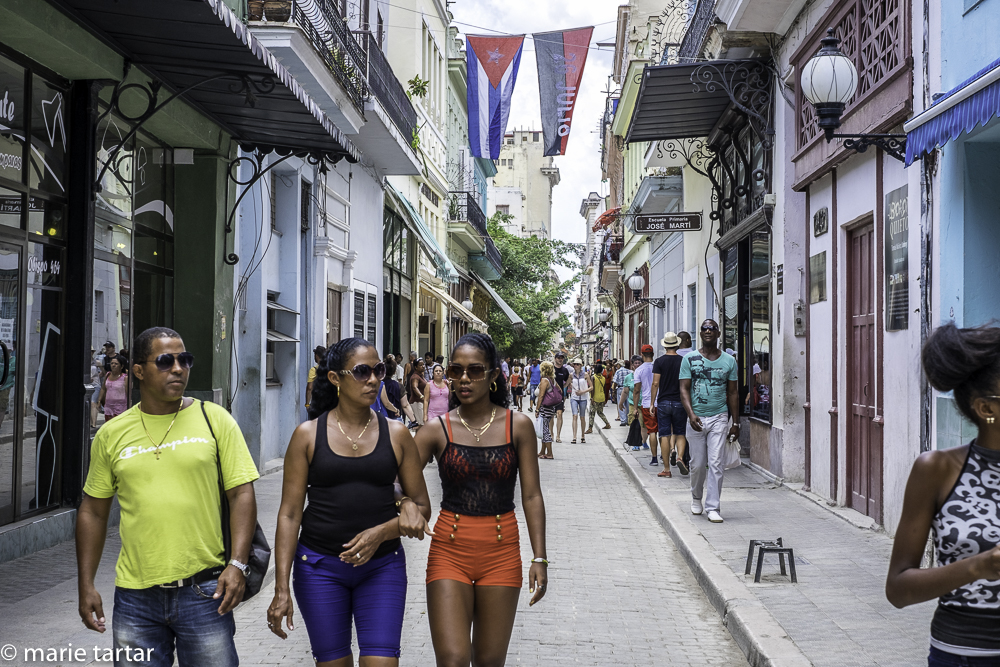
For a national holiday resulting in a 3 day closure of museums and embassies, the “celebration” of Revolution Day was rather tepid; banners in the streets, as depicted here, were most of it.
Fidel, with the aid of a small guerrilla army, eventually succeeded in forcing Batista to relinquish power in 1959. Under Fidel’s leadership, a series of agrarian, rent and income reforms were enacted. Large scale programs to improve education, health care and infrastructure were implemented. Cuba became a pivot point in the Cold War stand-off between the US and the USSR when the Cuban government ordered oil refineries (mostly US-owned) to process Soviet oil. Under pressure from the US government, they refused. Cuba responded by nationalizing the refineries, leading the US to retaliate by cancelling imports of Cuban sugar. In return, Cuba nationalized most US interests, namely banks and sugar mills. The US economic embargo began in 1960 and although there is now dialogue indicating support for eventually dismantling it, continues to this day. In Cuba, it is called bloqueo, and billboards proclaim: BLOQUEO: El genocidio mas largo de la historia (BLOCKADE – The longest genocide in history).
Cuba managed the economic difficulty imposed by the US. embargo for decades, thanks to support from the USSR. The collapse of the Soviet Union in 1989 led to Cuba’s decade-long “special period,” with widespread effects on transportation and farming. Very quickly, imports of petroleum from Russia, on which Cuba was dependent, came to a stop, grinding the transportation system to a halt. With no petroleum, there was no longer raw material for fertilizer to support the large-scale industrial farming then practiced. Within a short period of time, Cuba’s economy was transformed. Farming had of necessity to be transformed into small-scale, more organic practices.
Cubans as a populace lost weight, and near-famine conditions were widely experienced. The cute rodents we encountered on the beach in Jardines de la Reina, jutías, became threatened, as they were hunted by Cubans as a protein source.

Jutías were widely hunted for food during Cuba’s “special period” of deprivation. Animals (“peacocks, buffalo and even the rhea”) disappeared from the zoo, and domestic cats disappeared from the streets and onto dinner plates.
The “special period” difficulties were eased by Cuba’s alliance with Venezuela after 2000, with Hugo Chavez as an ally. Interestingly, the average Cuban’s weight loss of 20 pounds during the “special period” shortages had unexpected benefits, as indicated in an article published in the American Journal of Epidemiology: “During 1997-2002, there were declines in deaths attributed to diabetes (51%), coronary heart disease (35%), stroke (20%), and all causes (18%).”
The “special period” transformation of farming, limiting use of and run-off of pesticides, and the protected status of Jardines de la Reina since 1996, are major factors contributing to the healthy state of the park today. The number of visitors is strictly limited, and the only fishing permitted is catch and release. The only commercial fishing permitted is for lobster, which is not under threat, and was abundantly represented on our dinner plates while on the boat. The south coast of Cuba being sparsely populated and minimally developed helps, as does the distance of the archipelago from shore (50 miles, 3 hours by boat to get there). The 600 cays and islands stretch for 93 miles (150 km), forming the 3rd largest barrier reef in world. The Queen honored in the name bestowed by Christopher Columbus on Jardines de la Reina is none other than Isabella, Queen of Spain.
Other factors which have eased the “special period” privations include the passing of the governmental baton from Fidel to his brother Raúl, under whose leadership restrictions on private enterprise by ordinary Cubans have been eased. We saw abundant examples of these small enterprises, from women who sold baked goods in the street, to small lunch concessions operated out of garages, to paladares, privately owned restaurants.
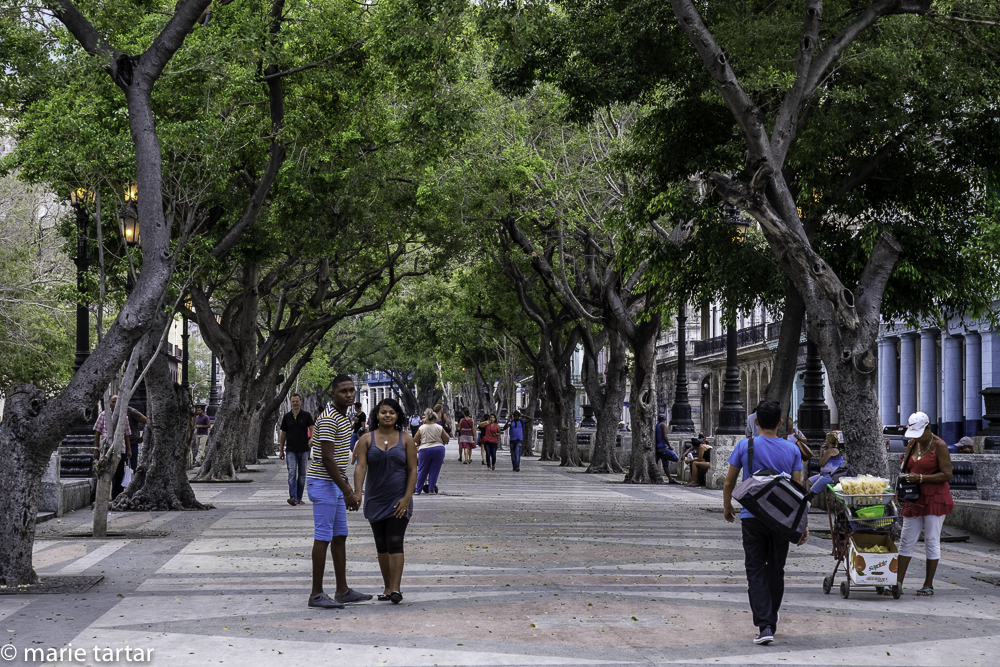
My favorite promenade, the Prado, near Parque Central; the woman in red to the right is an example of a small business enterprise, selling snacks to passersby
The casa particular we stayed in during our “extension” in Havana is another example.
Although our standard of living was of necessity greatly reduced from our first Havana stay to our second, we were still well sheltered. While we were touring police stations and trying to talk our way out of Cuba without passports on our intended departure day, our friend Greg had a closer brush with the grinding poverty that exists in Cuba, despite free medical care and government issued monthly food rations for staple items (beans, rice, oil, etc).
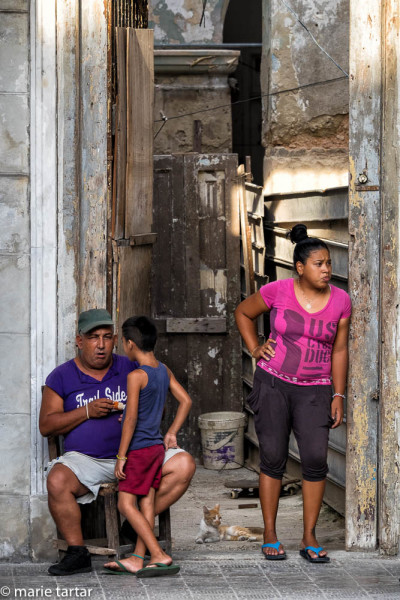
The amount of living which transpired on the street was astounding; my presumption was the apartment interiors were cramped, hot and squalid.
Greg’s story:
“I randomly met a local who gave me a tour of his home and I met his sister, father, brother, wife and child. He talked about what it was like living there.
The apartment was two units. The first looked as though the second floor had been rebuilt by them…a lofted space. It had the smallest of spiral staircases to the second floor. I am pretty sure that somewhere a child is crying because her doll’s house’s stairs are missing. The first apartment had an old television and a couch… a table, too. The couch looked like something the homeless people that live under the bridge had thrown out. The cooktop was a two burner propane unit for camping. It was on a counter that probably should have had a sink in it. I say this because I am sure that it had been part of the bathroom. The toilet was next to the cooktop.
The second floor was where he and his wife slept. It had a something that resembled thick cardboard, but I believe was a mattress. It was made up with filthy, or perhaps just stained by time, sheets. Old desk fans were used to move the thick air. One I was told was broken and the other was off, as he owed money on his electric bill and soon, as we were talking, it was shut off.
Next door, I didn’t get to go upstairs. This room had a fridge and another small stovetop. The bathroom was intact. While the lights were on, it glowed yellow orange. There was a small love seat across from two chairs. There was lots of stuff placed around the room. They supplemented their income by collecting aluminum and I think some of that was even in the room. There was a kitchen across in the corner by the entry. I would say the room was 10×15 feet. The fridge was bare save some reconstituted milk and something that was spoiling in a bowl.
I ended up giving him my T shirts, shorts, even underwear, for which he thanked me profusely. I felt bad giving it to him since it had been worn… he was happiest to be getting 4 pairs and made a point of telling me he owned only one pair. I also got rid of all my toiletries and gave him toilet paper that I stole from the (hotel) room. Everything I gave garnered a Christmas-like thank you. I felt terrible that things we take for granted were received with so much appreciation. That said, somewhere in Havana right now, someone is wearing my Zombie at Tiffanys T-shirt (Audrey Hepburn as an elegant zombie) and for that I couldn’t be prouder.”
That Cuba left a similar enduring effect on me was clear after our return. Steve, noticing my bicycle seat was worn, ordered me a new one. My reaction: “I could just wrap some plastic grocery bags around it and get years more use out of it.” I had noticed just this type of temporizing “repair” at the Malecón, during our morning with the fishermen. One of them rode in on a rust-bucket of a bicycle, with plastic bags wadded and wrapped around a metal skeleton of a seat, still in service long after we would have abandoned it as hopeless.
As for us, we are saddened by the difficult living conditions we observed , heartened by the fortitude and adaptability of the people we met, and hopeful the evolving changes we saw will continue to improve the lives of Cubans, who seem to be made of reserves of resiliency which are astonishing and inspirational. As for seeing it before it is “ruined” and “before it is invaded by Starbucks,” I think that is a long, long way off. To undo more than 50 years of deferred maintenance is tantamount to turning around an ocean liner, and will be a prolonged process, which I look forward to observing over the coming years.
-Marie
P.S.: Cuba related book and movie recommendations are below. For those who want more tales from Cuba, see Parts 1-4 of my blog, and Steve’s 4-part, wildly comic, but largely accurate, version, on the homepage under “From our blog,” or under the blog tab on top, or using the links that follow:
Marie’s:
Part 1: https://aperturephotoarts.com/scuba-in-cuba-july-2015-part-1-going/
Part 2: https://aperturephotoarts.com/la-habana-cuba-july-2015-part-2/
Part 3: https://aperturephotoarts.com/scuba-in-cuba-july-2015-jardines-de-la-reina-part-3/
Part 4: https://aperturephotoarts.com/down-and-out-in-havana-part-4-july-2015/
Steve’s:
Part 1: https://aperturephotoarts.com/adrift-in-havana-part-i-steve-eilenberg/
Part 2: https://aperturephotoarts.com/adrift-in-havana-part-ii-by-steve-eilenberg/
Part 3: https://aperturephotoarts.com/adrift-in-havana-part-iii-steve-eilenberg/
Part 4: https://aperturephotoarts.com/apa-exclusive-interview-with-the-author-of-adrift-in-havana/

Street-side dominoes game: I surmise this is a good hand in dominoes by the player on the right’s expression
Film and reading recommendations:
Our Man in Havana by Graham Greene. My sister Clarissa recommended both the book (1958) and the 1959 film starring Alec Guinness, and I’d second these recommendations. The Cold War concerns and sly tone brought perennial favorite “Dr. Strangelove” to mind. Vacuum cleaner salesman Wormold is recruited by the British secret service to be their “man in Havana,” feeding MI16 choice bits of information. The trouble is, he has none, and puts a fertile imagination to work in reporting to the home office. Reports of a secret military installation presage the actual Cuban Missile Crisis a few years later. The film was shot on location in Havana, 2 months after the Castro overthrow of the Batista government, so provides a time capsule look at Havana at the height of its heyday, before the long, inexorable slide of the coming decades.
“Fresa y chocolate” (Strawberry and Chocolate) (1994). I was interested to see this film for many reasons. It was filmed in the mansion which today houses one of the most venerable paladares, Paladar La Guarida, which was one of our favorite restaurants in Havana. The restaurant opened in 1996, drawing its name from the film. Openly gay protagonist Diego welcomes his straight new friend /potential love interest David to his apartment, his hideaway (la guarida de Diego). It is the only Cuban film ever to be nominated for an Academy Award, for Best Foreign Film. Taking place in Havana in 1979, the film takes place in the actual year in which consensual homosexual relations in Cuba were legalized after decades of repression, but came out during the decade in which there was a gradual easing of anti-gay sentiment.
Before Night Falls (Antes que Anochezca: autobiografía), Reinaldo Arenas’ 1992 autobiography (published in English in 1993) is a compelling narrative of the poet and writer’s early life in Cuba, his persecution by the Castro government as an openly gay writer in the 1960s and 1970s and his eventual exile in the US after departure with other “undesirables” on the Mariel Boatlift. The 2000 film version by Julian Schnabel is also excellent, starring Javier Bardem.
“Juan de los Muertos” (“Juan of the Dead”) is a slyly subversive 2010 zombie comedy. Dead-beat friends Juan and Lazaro, with a cadre of children and friends, initially assume zombies are dissidents, but capitalize on the situation by forming a service to rid others of their zombie relatives. “Juan de los Muertos: Matamos a sus Seres Queridos” (“Juan of the Dead: We kill your loved ones”) becomes their slogan.
“Papa: Hemingway in Cuba”, starring Adrian Sparks as Hemingway in his waning years, Joely Richardson as his last wife Mary, and Giovanni Ribisi as a junior Miami Herald reporter who idolizes Hemingway and is befriended by the couple. Directed by Bob Yari, it is the first Hollywood motion picture since 1959’s “Our Man in Havana” to be filmed in Cuba and Hemingway’s home turned museum, Finca La Vigia.
Waiting for Snow in Havana: Confessions of a Cuban Boy, by Carlos Eire, won the 2003 non-fiction National Book Award. He and his brother were 2 of 14,000 unaccompanied children who went sent to live in the US in 1962 as part of Operation Pedro Pan. Their privileged lives as the sons of a judge were turned upside down by the Castro takeover of Cuba, and the autobiographical account perfectly captures the outlook of a stunned child witness to historic events.
An excellent Netflix 4-part series, “Four Seasons in Havana” is based on the Havana Quartet of Mario Conde detective novels by Cuba’s best-known living writer, Leonardo Padura, who also wrote the screenplays. The fabulous Jorge Perugorría plays the hard-drinking, melancholic detective. Wonderfully atmospheric and highly recommended!


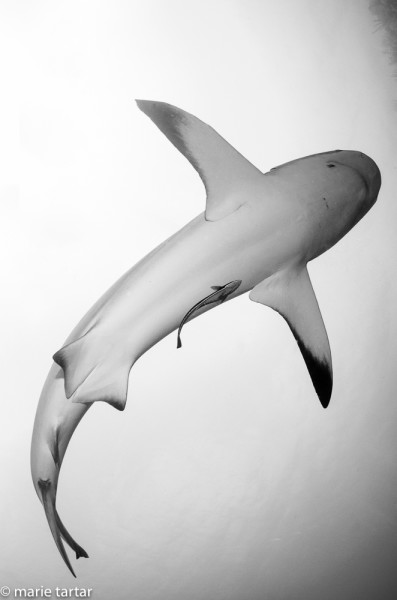
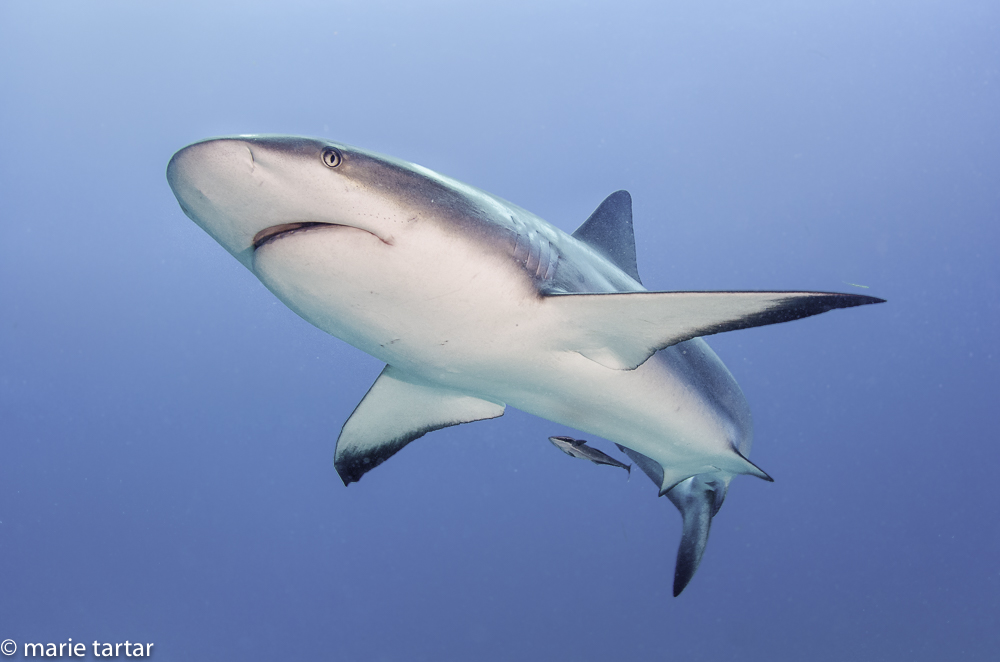
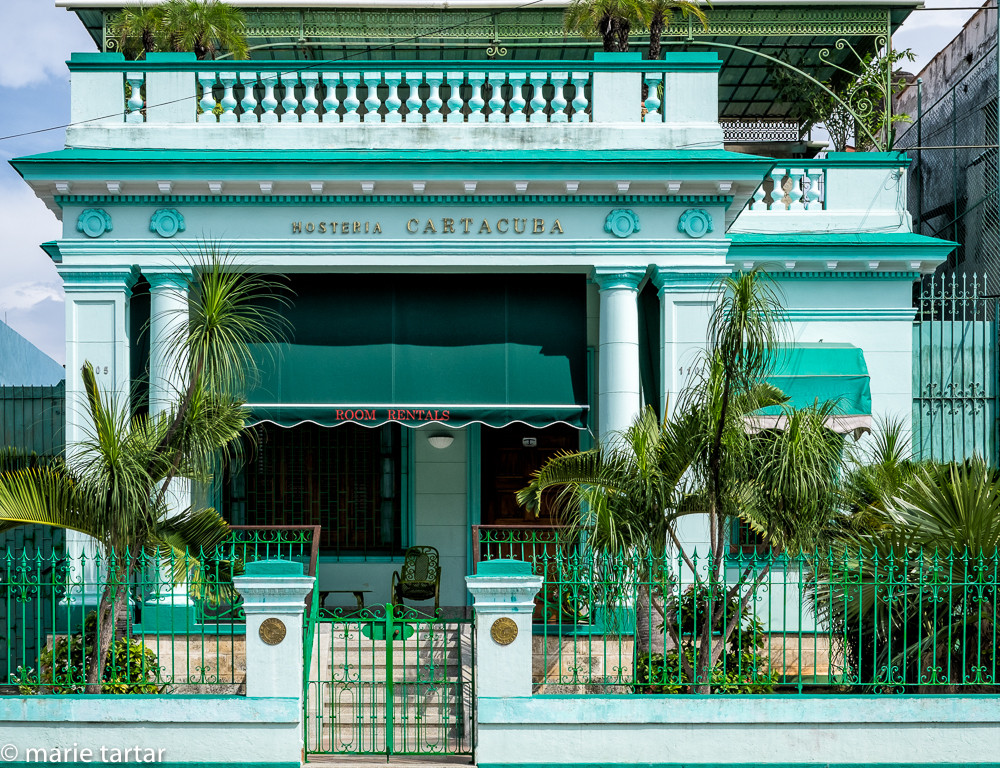
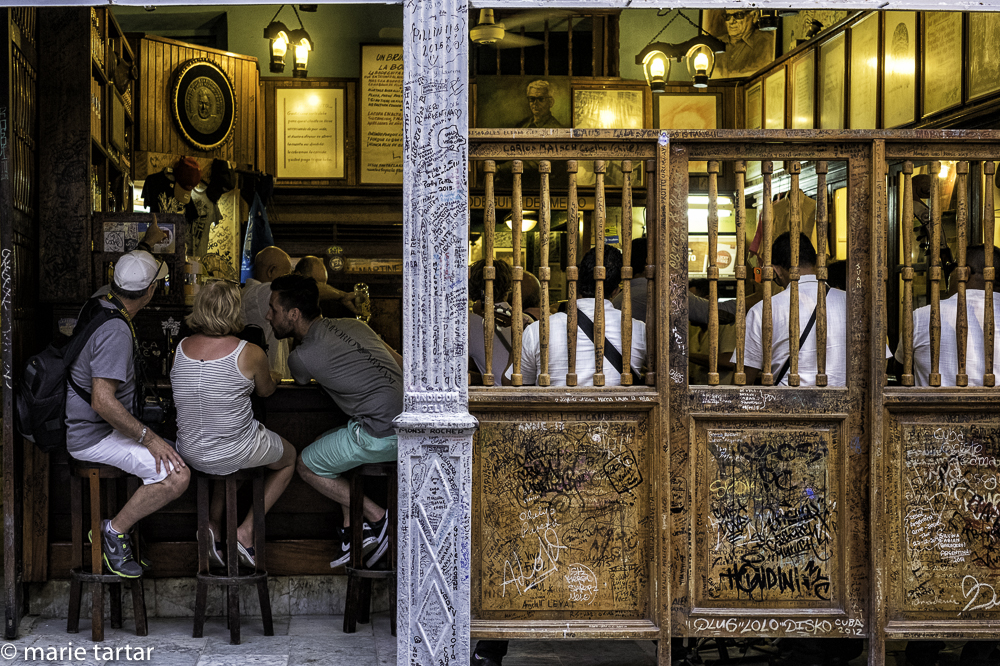
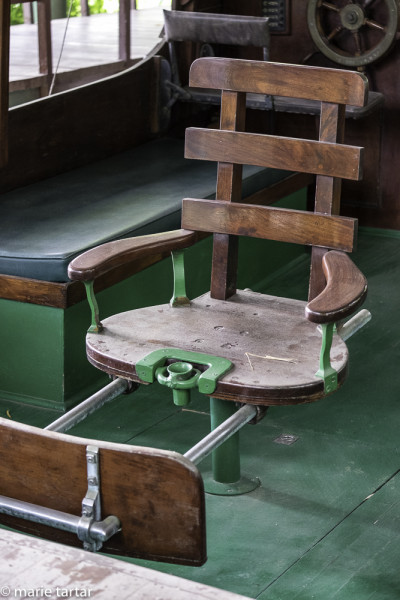

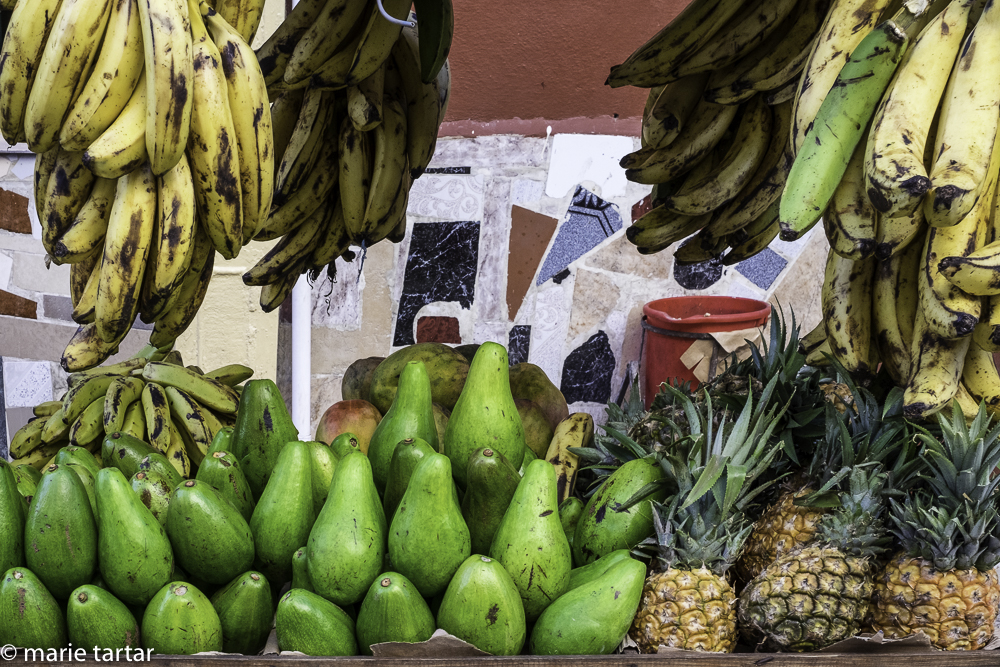
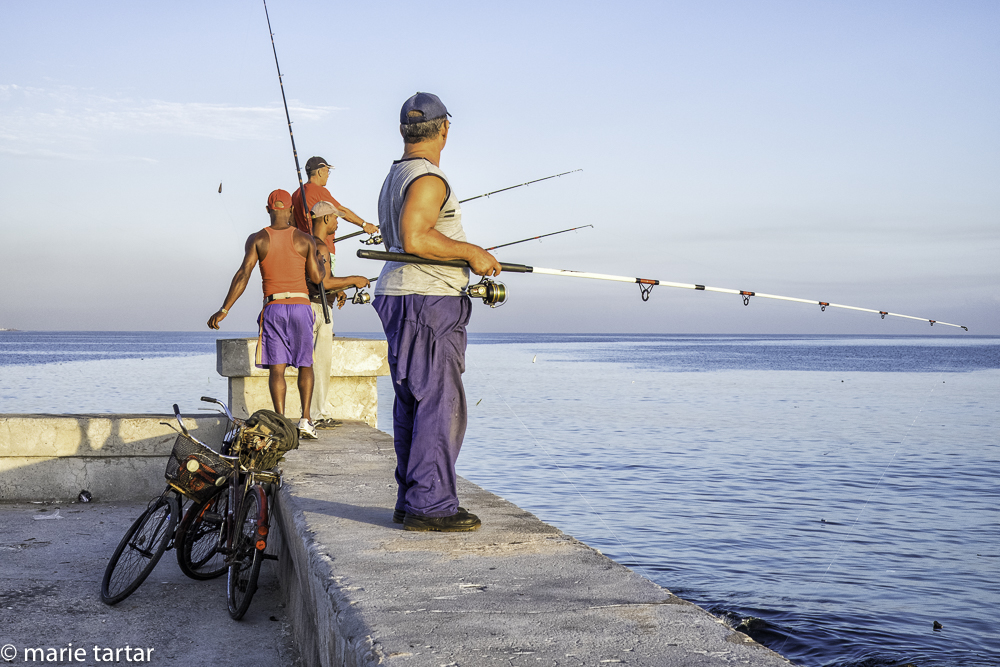
Loved the writing, darn you are good, almost like hearing it all. See you when I return for France